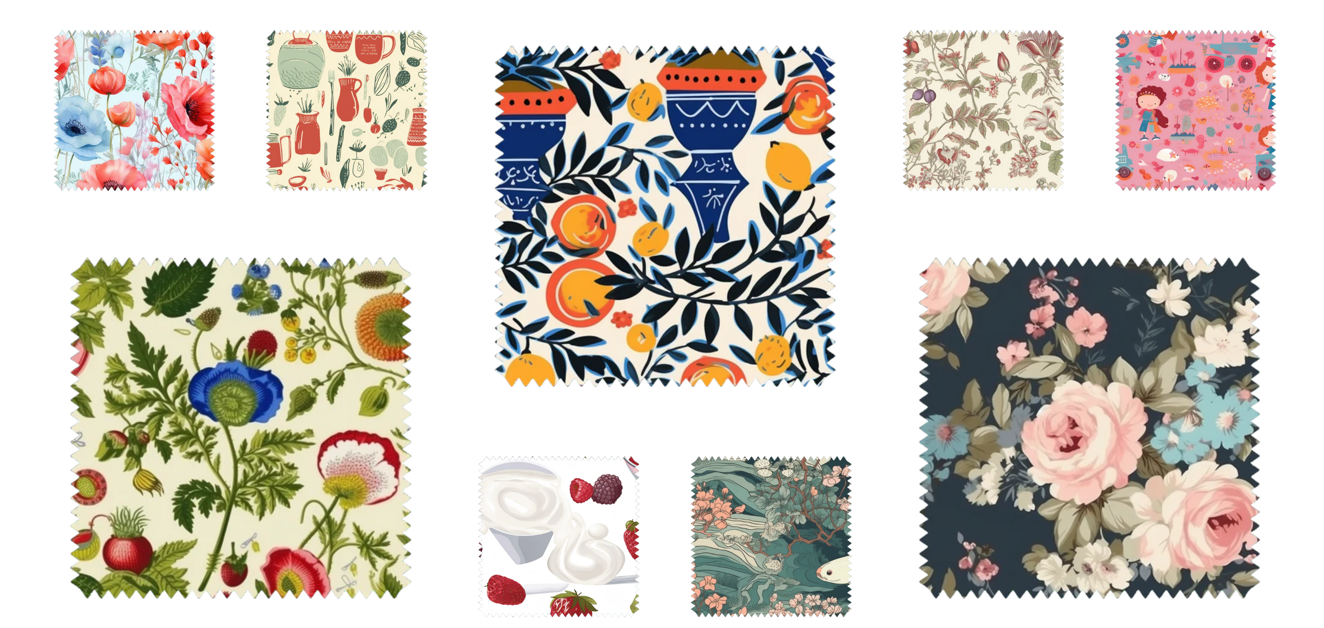When tinkering with a few AI image generators, Danny quickly realized how effective AI is at creating repeating patterns. It reminded him of one of his clients and how they're uniquely positioned to adapt a technology like this one.
The client, The Millshop Online, sells fabric and prints and also distributes its own fabric designs in the UK. Danny thought: What if these repeating patterns could be printed on fabric and sold as a unique product?
Danny approached The Millshop’s CEO with this idea: The Millshop could offer a public-facing, AI-powered service allowing customers to create one-of-a-kind fabrics on demand. Customers would describe the fabric they want or upload a photo of their room, and within minutes, they'd receive design options, which they could then purchase directly from The Millshop.
Despite being in an industry that’s been resistant to adopt new technology, the CEO greenlit the project. Danny was thrilled to start building but quickly experienced some roadblocks.
Building an AI service without a team of developers
This service, dubbed FabricGenie, would be the first of its kind, so Danny knew this project needed to launch quickly and in the most cost-effective way for his client.
Not only did Danny have to develop the AI-powered service, but he also needed to create a landing page, copy, imagery, and more. On top of that, there were different risks he needed to prepare for, like if the system was overwhelmed with too many submissions at once, or if someone used inappropriate language or images. The project was a huge undertaking for one person.
“Zapier is my playground, so it was my first thought when it came time to create this. Zapier is so tightly integrated with many different AI tools and models, so I knew it would make this process easier.”
—Danny Richman, Richman SEO
Danny used Zapier and multiple AI tool integrations to do the bulk of the work for the initial creation. Then he leaned on the powerful pairing of automation and AI to keep the service running.
AI and automation do the heavy lifting
There are about 85 Zaps powering the service, including four that just handle the initial request. The tool works in stages: The first stage handles moderation, the second manages the queue, the third processes the custom image, and the fourth and final stage is the HTML-formatted email with images and links to order samples.
In addition to tackling those crucial tasks, Zapier also manages many of the behind-the-scenes processes and administrative tasks. For example, if a request gets stuck, Zapier manages the notifications and troubleshoots to run those tasks again. Zapier also powers the internal logging to provide Danny and the Millshop team with data about usage and orders.
With Zapier and AI managing most of the system, they were able to save resources for the few tasks they couldn’t automate, like hiring a developer to build the front-end page.
“I can’t think of any other way we could have done this. No other platform or competitor would have been capable of building this,” said Danny.
“The time and cost element is down because of Zapier. If we’d coded this from scratch, I would have had to bring in an entire team. Instead of that, I used Zapier, which saved around $40,000 in the creation of FabricGenie.”
Ideation to launch in only 12 weeks
Ultimately, the entire lifecycle from ideation to product launch took only 12 weeks, which wouldn’t have been possible with a traditional development team.
Instead, they relied on automation and AI for every facet of the process. They used Midjourney to create the robot character they used throughout the page and marketing for the tool. They created the code using GPT-4 and even debugged the code with AI as well.

The experiment quickly proved to be a success. FabricGenie received over 2,000 requests just two days after launching in June, and The Millshop Online has already sent out and sold many products based on the FabricGenie designs.
The AI tool was a hit with industry insiders, too. Not only are they seeing requests and even press coverage, but they’re also seeing increased interest in the U.S. They’ve even heard from other furnishing and fabric retailers that are interested in partnering with them and using the tool themselves.
Combining Zapier with the power of AI is driving innovation and creating new opportunities for even the most traditional industries.


